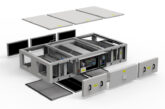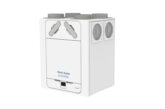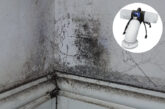
Market-leading British ventilation manufacturer, Vent-Axia, is delighted to support BEAMA’s ‘Guidance for Improving Indoor Air Quality in Existing Homes’. Launched on 27 June 2023, in the BEAMA Village at the InstallerSHOW, NEC, the guide explains the risks of poor indoor air quality in existing homes due to inadequate ventilation and then sets out general ventilation guidance in three parts: ventilation requirements when undertaking energy efficiency measures; selecting and installing suitable extract ventilation and commissioning new or upgraded ventilation in dwellings.
In ‘normal’ times we spend around 90% of our time indoors and around 16 hours a day on average at home. However, since the pandemic we are spending even more time at home, with data on remote and hybrid working showing in September 2022 around 1 in 5 (22%) of the GB workforce had worked at lease one day from home in the previous week and 1 in 8 (13%) worked at home exclusively. This makes the potential risk of exposure to indoor air pollutants significantly greater than outdoor air, especially considering indoor air is many times more polluted. When adding energy efficiency measures to an existing home it is therefore vital to consider whether these changes affect ventilation and if it still complies with Building Regulations.
The BEAMA guidance therefore explains how Part F of the Building Regulations requires contractors carrying out energy efficiency measures to an existing dwelling to undertake an assessment to determine what, if any, additional ventilation is needed, based on the estimated impact of work. This involves installers considering all energy efficiency measures undertaken since a home was first built. The guide sets out how to calculate which category a home falls into and how this determines what ventilation is required. With category C, natural ventilation does not comply with Part F without a full design by a competent person.
As well as summarising some of the critical requirements of Part F, BEAMA also offers guidance on how to select and install suitable ventilation. This provides useful details on minimum extract rates for fans to ensure a correctly sized fan is specified so it ventilates effectively and does not under or over ventilate. Commissioning is also critical to ensure effective ventilation, BEAMA’s guide therefore also explains, how it is now a legal requirement under the updated Building Regulations to complete and submit a commissioning sheet. This is enforceable by a local authority building control service or an approved private building inspector. If an installer is registered with a recognised competent person scheme, such as the NICEIC, they may be able to self-certify some or all of the work carried out.
“At Vent-Axia we support BEAMA’s guidance on indoor air quality in existing homes. Over the last few years, we have all seen the real consequences of sealing up homes and insulating them to make them more energy efficient, resulting in indoor air pollution. Amended Part F has started to redress the balance of ventilation with energy efficiency, however, not everyone is aware of the changes or how to comply with them. The BEAMA guide provides useful guidance for installers on how to comply with Part F and provide effective ventilation, and so improve indoor air quality in existing homes. The easiest and safest way for installers to comply with Part F is to choose continuous ventilation for existing homes since it is compliant with both category B and C,” said Natasha King, Product Manager at Vent-Axia.
There is a wide range of different types of continuous ventilation for installers to choose from to ensure exactly the right solution. For example, at Vent-Axia we offer the Lo-Carbon Svara which offers condensation control, which helps improve IAQ and is backed up by easy installation, quiet operation and is controllable via a smartphone. Meanwhile, the Vent-Axia PureAir Sense is the UK’s only bathroom fan with Odour Sense technology that increases airflow when the air quality is poor, helping ensure a comfortable living environment. Alternatively, there are de-centralised mechanical extract ventilation (dMEV) units, such as the Lo-Carbon NBR dMEV C, which is highly efficient with its exceedingly low Specific Fan Power (SFP) values as impressively low as 0.08 w/l/s and provides almost silent operation at 7.4dB(A).
Meanwhile, for installers aiming to help landlords tackle condensation and mould and improve IAQ, Vent-Axia’s Lo-Carbon Revive, an intelligent filterless unitary fan, boasts powerful, quiet and efficient ventilation, and features an adjustable trickle speed. Alternatively, the intelligent Lo-Carbon Response 7 is a filterless unitary fan that features an ultra-low profile for discreet installation; increased airflow performance; a digital control menu as well as a 7-year guarantee. With six models (including 100mm and 125mm options), the range boasts flexibility built into the digital control menu allowing it to meet the variety of needs encountered in social housing properties by offering continuous ventilation, as well as constant volume and SELV options.
Vent-Axia is committed to improving IAQ and energy efficiency and has produced a useful Building Regulations webinar for installers to explain the new requirements.
To view the recorded webinar visit: https://www.vent-axia.com/building-regulations-webinars.
For further information on continuous ventilation offered by Vent-Axia telephone +44 (0)344 856 0590 or visit the website here










